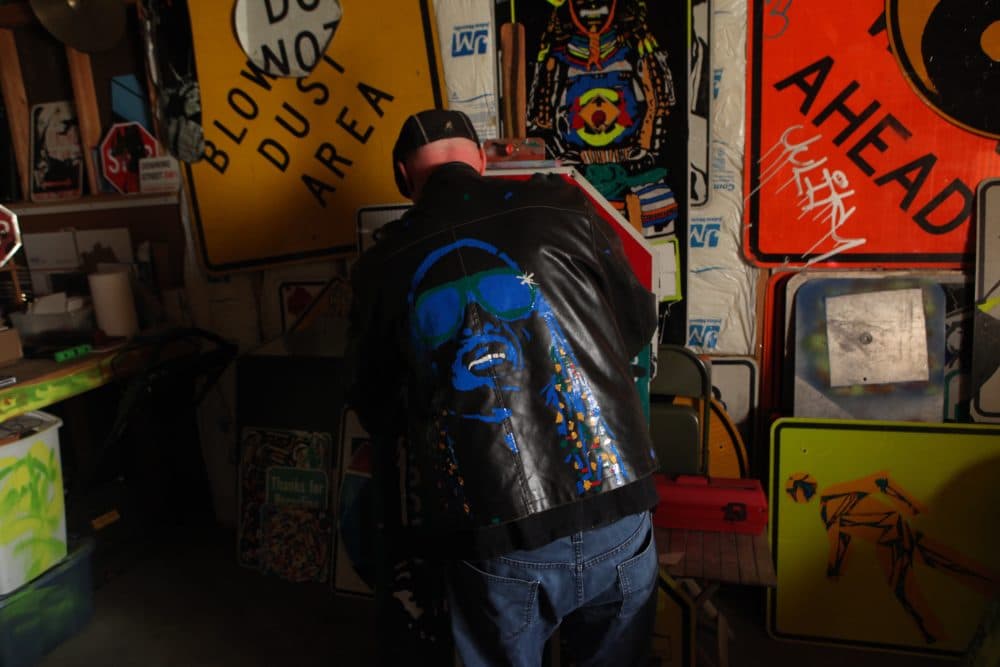
Dan Ericson's legends are rappers and hip-hop artists and in a weird way, the reverse is true too.
"People knew there was this kid who will give you street signs, but with your face on them, if you go through Denver," the 39-year-old explained in an interview at his southwest Denver home.
Take, for example, the emcee Black Thought. Ericson and his wife caught Mr. Thought waiting for a cab outside Fox Theatre in Boulder and presented a gift: his group, The Roots, but on a street sign.
Some people might be surprised by that. Not Black Thought, who is known for thinking on his feet. He already knew who Ericson was. He even gave the artist an instant nickname: The Signtologist. And then he asked for a ride back to his hotel room.
Now, Ericson has embraced the name as his brand. What started as a failed college art project has become his artistic persona. His work has ended up in Questlove's studio, and one of his signs sent Rakim into a meditative trance. Grandmaster Flash, Pharrell Williams, Saul Williams and the RZA also are recipients.
Soulja Boy was too. But he lost his.

Dan Ericson holds a miniature stop sign with a depiction of Biggie Smalls. (Andrew Kenney/Denverite)
Ericson stumbled into the style late one night as a graphic design student at Arapahoe Community College in his early 20s, working on a series of facial studies.
"It stemmed from a mistake, and it's one big learning process," Ericson explained.
"I just screwed up a project and didn’t have anywhere to get a canvas from and just ended up using a street sign I had in the carport," he said. He drew Ice Cube on it. He didn't get a great grade but he stuck with the style and the subject.
"I'd always been very enamored by hip-hop culture and that type of music, so I tried to incorporate that into my art," he said. Next, he somehow got a painting of Jedi Mind Tricks on a no-parking sign into Fox Theatre.
Ericson loves hip-hop, having grown up as a kid pushing a lawnmower through neighbors' yards while blasting Public Enemy's "Fear of a Black Planet."
"Anybody I wanted to get a piece of art, I would just go and schmooze," he explained
"Then I’d go and repeat that 200 plus times over the course of eight years," he said. "When I realized it provided me access, 'I'll just use this as a backstage pass.'"

Over the years, he learned more about his medium. He discovered that they take on cartoonishly bright colors under a camera flash, and he figured out how to make his ink stick.
"There are different grades, different metals that are used," he said. "More of them lately are aluminum, but you do find some steel signs from back in the day," he said. Now he's working with rolls of reflective sheeting and vinyl scraps.
He made friends with other sign artists -- like Boris Bally, who bends them into tables -- and figured out how to procure them legally from suppliers.
"If I was to go steal a stop sign, it could lead to vehicular homicide," he said. Instead, he "had different connections through different municipalities. I literally am the squeaky wheel that gets the grease. I just bug people."

Only three people ever rejected their signs, although occasionally one would end up in a broom closet. Soulja Boy lost his within 20 minutes and came back to ask about it.
His portrait of the composer Charlier Parker has even been accepted to the American Jazz Museum in Kansas City. "The stuff it’s next to is ridiculous — a horn that Charlie Parker played, a Picasso painting of Ella Fitzgerald."
By now, he's met almost all the musicians he wanted to meet, everyone whose face he had plastered on his wall as a kid. Still, he plans to keep working in his unusual format, selling his work a way to support his two young kids -- and maybe to leave behind a sign for others to follow.
If you want to see it, Ericson's work is on display at the following Denver locations in Denver as of Friday:
- The Preservery
- Dazzle
- The Brutal Poodle
- Levitt Pavilion's green rooms











